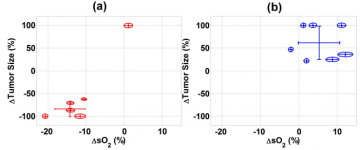In order to determine efficacy of a certain treatment, therapeutic biomarkers can be measured. With doxorubicin cancer therapy specifically, oxygen saturation levels can help determine efficacy of treatment.
The efficacy of HT-HaT-DOX liposomes can be determined via ultrasound-guided photoacoustic imaging and oxygen saturation histograms (Figure 1 below). Prognosis of treatment outcome with HaT-DOX TSL (heat activated cytotoxic thermosensitive liposome) can be determined by measuring sO2 as a surrogate marker.

Figure 1. Treatments that did not show efficacy (such as HT-saline arm and 10% of HT-HaT-DOX arm) did not show significantly reduced sO2 (>10%) at 30 minutes post-treatment but treatments with significantly reduced sO2 did. Longitudinal treatment success can be determined by noninvasive imaging of sO2 as a prognostic biomarker. From May et al. PLOS ONE 2016 Oct; 11(10): e0165345. doi:10.1371/journal.pone.0165345

Figure 2. A correlation is seen between change in oxygen saturation levels and change in tumor size. Oxygen saturation levels were taken 30 minutes before injection and 2 hours post injection to find the change. HT-Saline was given in Figure 2a and HT-HaT-DOX was given in Figure 2b. From May et al. PLOS ONE 2016 Oct; 11(10): e0165345. doi:10.1371/journal.pone.0165345